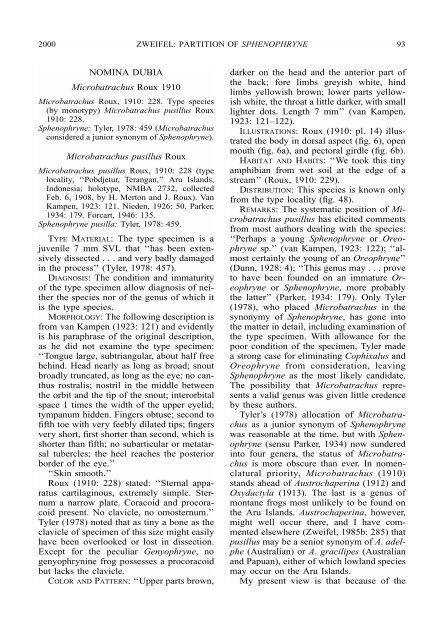SPHENOPHRYNE - American Museum of Natural History
SPHENOPHRYNE - American Museum of Natural History
SPHENOPHRYNE - American Museum of Natural History
You also want an ePaper? Increase the reach of your titles
YUMPU automatically turns print PDFs into web optimized ePapers that Google loves.
2000 ZWEIFEL: PARTITION OF <strong>SPHENOPHRYNE</strong><br />
93<br />
NOMINA DUBIA<br />
Microbatrachus Roux 1910<br />
Microbatrachus Roux, 1910: 228. Type species<br />
(by monotypy) Microbatrachus pusillus Roux<br />
1910: 228.<br />
Sphenophryne: Tyler, 1978: 459 (Microbatrachus<br />
considered a junior synonym <strong>of</strong> Sphenophryne).<br />
Microbatrachus pusillus Roux<br />
Microbatrachus pusillus Roux, 1910: 228 (type<br />
locality, ‘‘Pobdjetur, Terangan,’’ Aru Islands,<br />
Indonesia; holotype, NMBA 2732, collected<br />
Feb. 6, 1908, by H. Merton and J. Roux). Van<br />
Kampen, 1923: 121. Nieden, 1926: 50. Parker,<br />
1934: 179. Forcart, 1946: 135.<br />
Sphenophryne pusilla: Tyler, 1978: 459.<br />
TYPE MATERIAL: The type specimen is a<br />
juvenile 7 mm SVL that ‘‘has been extensively<br />
dissected . . . and very badly damaged<br />
in the process’’ (Tyler, 1978: 457).<br />
DIAGNOSIS: The condition and immaturity<br />
<strong>of</strong> the type specimen allow diagnosis <strong>of</strong> neither<br />
the species nor <strong>of</strong> the genus <strong>of</strong> which it<br />
is the type species.<br />
MORPHOLOGY: The following description is<br />
from van Kampen (1923: 121) and evidently<br />
is his paraphrase <strong>of</strong> the original description,<br />
as he did not examine the type specimen:<br />
‘‘Tongue large, subtriangular, about half free<br />
behind. Head nearly as long as broad; snout<br />
broadly truncated, as long as the eye; no canthus<br />
rostralis; nostril in the middle between<br />
the orbit and the tip <strong>of</strong> the snout; interorbital<br />
space 1 times the width <strong>of</strong> the upper eyelid;<br />
tympanum hidden. Fingers obtuse; second to<br />
fifth toe with very feebly dilated tips; fingers<br />
very short, first shorter than second, which is<br />
shorter than fifth; no subarticular or metatarsal<br />
tubercles; the heel reaches the posterior<br />
border <strong>of</strong> the eye.’’<br />
‘‘Skin smooth.’’<br />
Roux (1910: 228) stated: ‘‘Sternal apparatus<br />
cartilaginous, extremely simple. Sternum<br />
a narrow plate. Coracoid and procoracoid<br />
present. No clavicle, no omosternum.’’<br />
Tyler (1978) noted that as tiny a bone as the<br />
clavicle <strong>of</strong> specimen <strong>of</strong> this size might easily<br />
have been overlooked or lost in dissection.<br />
Except for the peculiar Genyophryne, no<br />
genyophrynine frog possesses a procoracoid<br />
but lacks the clavicle.<br />
COLOR AND PATTERN: ‘‘Upper parts brown,<br />
darker on the head and the anterior part <strong>of</strong><br />
the back; fore limbs greyish white, hind<br />
limbs yellowish brown; lower parts yellowish<br />
white, the throat a little darker, with small<br />
lighter dots. Length 7 mm’’ (van Kampen,<br />
1923: 121–122).<br />
ILLUSTRATIONS: Roux (1910: pl. 14) illustrated<br />
the body in dorsal aspect (fig. 6), open<br />
mouth (fig. 6a), and pectoral girdle (fig. 6b).<br />
HABITAT AND HABITS: ‘‘We took this tiny<br />
amphibian from wet soil at the edge <strong>of</strong> a<br />
stream’’ (Roux, 1910: 229).<br />
DISTRIBUTION: This species is known only<br />
from the type locality (fig. 48).<br />
REMARKS: The systematic position <strong>of</strong> Microbatrachus<br />
pusillus has elicited comments<br />
from most authors dealing with the species:<br />
‘‘Perhaps a young Sphenophryne or Oreophryne<br />
sp.’’ (van Kampen, 1923: 122); ‘‘almost<br />
certainly the young <strong>of</strong> an Oreophryne’’<br />
(Dunn, 1928: 4); ‘‘This genus may . . . prove<br />
to have been founded on an immature Oreophryne<br />
or Sphenophryne, more probably<br />
the latter’’ (Parker, 1934: 179). Only Tyler<br />
(1978), who placed Microbatrachus in the<br />
synonymy <strong>of</strong> Sphenophryne, has gone into<br />
the matter in detail, including examination <strong>of</strong><br />
the type specimen. With allowance for the<br />
poor condition <strong>of</strong> the specimen, Tyler made<br />
a strong case for eliminating Cophixalus and<br />
Oreophryne from consideration, leaving<br />
Sphenophryne as the most likely candidate.<br />
The possibility that Microbatrachus represents<br />
a valid genus was given little credence<br />
by these authors.<br />
Tyler’s (1978) allocation <strong>of</strong> Microbatrachus<br />
as a junior synonym <strong>of</strong> Sphenophryne<br />
was reasonable at the time, but with Sphenophryne<br />
(sensu Parker, 1934) now sundered<br />
into four genera, the status <strong>of</strong> Microbatrachus<br />
is more obscure than ever. In nomenclatural<br />
priority, Microbatrachus (1910)<br />
stands ahead <strong>of</strong> Austrochaperina (1912) and<br />
Oxydactyla (1913). The last is a genus <strong>of</strong><br />
montane frogs most unlikely to be found on<br />
the Aru Islands. Austrochaperina, however,<br />
might well occur there, and I have commented<br />
elsewhere (Zweifel, 1985b: 285) that<br />
pusillus may be a senior synonym <strong>of</strong> A. adelphe<br />
(Australian) or A. gracilipes (Australian<br />
and Papuan), either <strong>of</strong> which lowland species<br />
may occur on the Aru Islands.<br />
My present view is that because <strong>of</strong> the
















